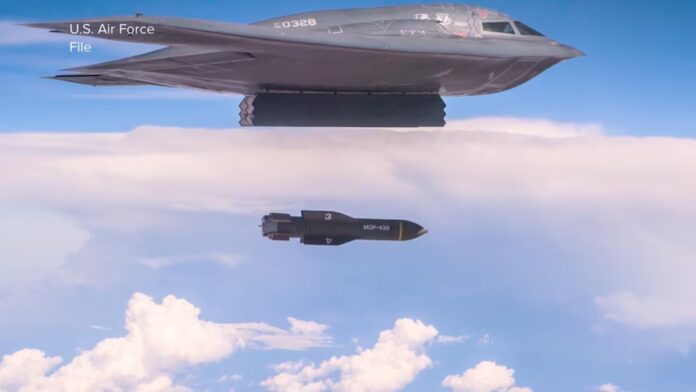Trump Questions the Strategy of a Strike
Former President Donald Trump has voiced doubts about striking Iran’s Fordow nuclear site using bunker buster bombs, even after Pentagon pressure. According to journalist Hugo Lowell from The Guardian, Trump said, “I have been asked about it by everybody but I have not made a decision,” reflecting hesitation despite Israel’s lobbying. He appears skeptical that the GBU-57 could destroy the heavily fortified underground site embedded within a mountain outside Qom. Officials confirmed Trump’s reluctance, stating, “We are going to be ready to strike Iran,” but the president “is just not convinced we are needed yet.” Trump’s indecision stems from the possibility that the damage may not last, and the facility could be rebuilt in months.
Massive Ordnance Penetrator Faces Real Barriers
The GBU-57 Massive Ordnance Penetrator (MOP), weighing approximately 30,000 pounds, was developed as America’s most powerful non-nuclear bunker buster. According to the Department of Defense and referenced by multiple publications, this bomb uses gravity and military-grade GPS to penetrate deeply hardened targets. While it can reportedly reach depths of 200 feet, the Fordow site is estimated by Israeli intelligence to be buried as deep as 300 feet. Analyst Eli Clifton of the Quincy Institute described the nuclear strike conversation as disturbing, observing, “It is disturbing but not surprising how the entire Executive Branch communications apparatus can be activated into total war-hysteria mode overnight.” The science suggests this weapon, dropped from a B-2 bomber, cannot guarantee a complete destruction of Fordow’s centrifuges.
Fordow’s Structure Was Built to Survive
The Fordow Fuel Enrichment Plant was buried underground deliberately, meant to avoid detection and endure sustained aerial assaults from powerful nations. According to the Bulletin of the Atomic Scientists, “Fordow… could in theory continue to operate even after other nuclear facilities in the country have been destroyed.” Fordow houses Iran’s IR-6 centrifuges and contains enough uranium hexafluoride to potentially produce several weapons if left operational. The Iranian engineers used complex tunneling and reinforced concrete—possibly with offset structures—to reduce vulnerability to overhead bomb impacts. Military analyst Randy Manner stated in The Guardian, “It might set the program back six months to a year. It sounds good for TV but it’s not real.”
Weapon Deflection and Impact Angles Matter
Military testing shows that projectiles like the GBU-57 often deflect when they strike surfaces that are angled or layered with resistance. During a televised technical briefing, one defense expert explained that angled surfaces can cause the munition to miss its intended path entirely. “You have a munition that’s very long and very fast… if it hits at an angle, it can deflect,” he said. Peer-reviewed research, including Chinese studies referenced by defense analysts, supports that composite barriers like diamond-shaped concrete formations can mislead or deform the strike trajectory. Without a perpendicular strike path and precise knowledge of Fordow’s layout, even the most powerful bomb may hit air or rubble instead of its intended target.
The Bomb’s Promise Has Never Been Tested in Combat
Despite years of development and testing, the GBU-57 has never been used in live combat, and remains a theoretical solution for deeply buried targets. One U.S. official told, “The bunker buster will work. It is not a capabilities issue.” Still, military decision-makers remain divided, with assessments from the Defense Threat Reduction Agency cautioning that even a full strike may only collapse tunnels and bury entrances. The same official added, “There’s an entire plan… it’s not just drop a bunker buster and declare victory.” The real-world performance of this weapon remains unknown, making the outcome speculative.
Israel Cannot Deliver a Strike Alone
Israeli officials have repeatedly acknowledged that they do not possess the weapons or aircraft needed to strike Fordow successfully from the air. “We are the only ones who have the capability to do it, but that does not mean I am going to do it,” Trump said. Some Israeli plans included commando raids, and Israeli Ambassador Yechiel Leiter suggested they “may do it with humans,” referencing past sabotage missions. Trump has dismissed those options as unrealistic given the risk and complexity of breaching an underground facility by foot. That leaves the United States as the only actor with the logistical reach and weaponry, but the capability remains limited by physics, not policy.
A Threat Built on Assumptions and Rhetoric
Trump’s national security meetings reflect a growing sense of urgency, with one U.S. official said, “The president’s patience is running thin every minute that passes.” Still, that urgency does not align with the bomb’s actual limitations, which raise questions about the strategy’s purpose. Without verifiable impact on Fordow’s deeper structures, a strike may achieve political optics without neutralizing Iran’s enrichment capabilities. As one military source stated bluntly, “We are not convinced yet that we are necessary.” With Iran signaling resistance to negotiations under pressure, the idea that ambiguity or show of force will succeed remains in doubt.

